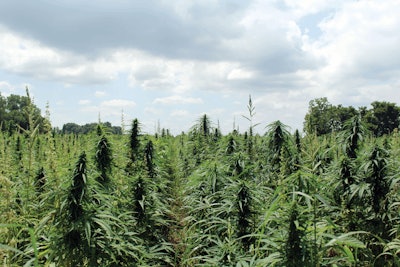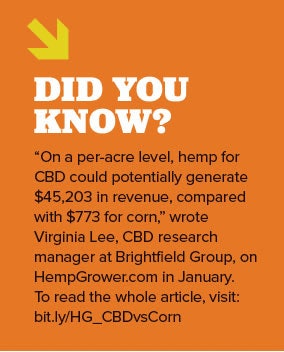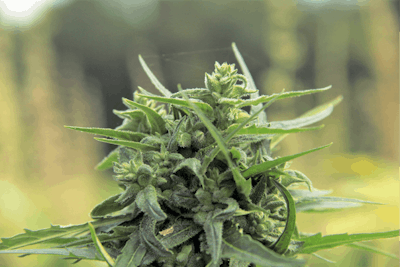

If you took a drive through the Heartland states on a summer day, you would likely see an ocean of corn or soybean fields. While this region produces other crops, corn and beans make up a majority of the agricultural landscape. In Indiana alone, farmers planted 5 million acres of corn and 5.4 million acres of soybeans in 2019, according to the U.S. Department of Agriculture (USDA). Corn and beans are standards for crop rotation, occasionally alternated with other crops, like wheat. Row crop producers, who often seek other options to break up their rotations, are now exploring adding hemp to their rotations because of its potentially higher returns than standard crops.
While producing hemp for grain or fiber would fit well within a row crop model, most hemp acreage is dedicated to cannabinoid production right now. And when I get calls from row crop farmers, they are most keen on learning about producing hemp for cannabinoids and essential oils, which requires methods more akin to growing specialty crops. By specialty crops, I mean intensively managed horticultural crops—think watermelons, tomatoes or tobacco.
Higher value returns of producing hemp for cannabinoids has drawn corn and bean producers in, even though they are not equipped to handle the increased demands (labor, new equipment costs and horticultural skill set) that specialty crops require.

Row crop farmers, however, have an opportunity to fit cannabinoid production into their current operations without completely changing what is familiar to them.
Behind the Novel Production Model
I first heard about producing row crop-style CBD hemp from a Colorado farmer who spoke at an event in 2019. This type of production was appealing to me, and luckily, I had the opportunity to collaborate with New West Genetics, a Colorado-based hemp genetics company, along with other Midwest extension educators to bring this novel production model to the spotlight in a recent webinar Purdue University hosted. (You can view the webinar at bit.ly/Purdue_rowcropCBD.) I wanted to share that we do have options outside of the labor-intensive production model we all know about.
Let me be clear, this is not a production model that would work for craft flower production (smokable products), but it could be a great option for extraction.
There are some important details to be aware of regarding this novel production model, including genetics, equipment and cost of production.
Genetics: First, the CBD hemp varieties being used for this row crop model are not feminized seeds nor transplanted clones, as are commonly used in traditional CBD cultivation. This is a direct seeding method using non-feminized dioecious (male and female) seeds and standard planting equipment—ideally whatever is already on the farm.
The most important genetic factor when choosing a hemp variety (whether you will be using this row crop model or not) is the tetrahydrocannabinol (THC) content the plants will produce. Keeping THC at or below the 0.3% threshold is critical, as if it exceeds that level, it will no longer be legal to sell per the Agricultural Improvement Act of 2018, aka the 2018 Farm Bill.
Second to this, homogeneity in phenotypes (the physical expression of genetics) across a population of one variety is also highly desirable. Homogeneity in plant size and date to maturity are two traits that are standard in row crops, but not in hemp. When a hemp grower purchases feminized seed, they are paying a premium to have an almost entirely female population, but not necessarily for traits such as plant size. A bag of feminized hemp seed can contain many phenotypes, resulting in vastly different plants in the field and the occasional male, which can reduce CBD yield for surrounding female plants.
Pollen drift from neighboring fiber or grain hemp farms is another threat that makes a dioecious system advantageous. Searching for and removing males is achievable in a feminized system, but it is not possible to control other neighboring hemp growers producing for grain or fiber. Feral hemp growing across the Midwest also poses other potential cross-pollination issues.
In a dioecious crop, you are not controlling males nor pollination, so CBD yield per plant is lower than in an all-female system; however, the number of plants per acre is much greater when growing using the row crop system.

Equipment: As mentioned previously, planting equipment found on a row crop farm will work for this type of hemp production. A 7.5-inch grain drill or 30-inch planter is ideal, but slight variations in spacing would be fine. The main advantage to tighter row spacing is quicker canopy closure, which will cause weeds to get shaded out earlier in the season. Because hemp has no synthetic herbicide options, early season weed control is critical.
When it's time to harvest, farmers will have a dual crop to manage. Equipment has to separate the seeds from the remaining flower, and while this process is still being optimized, a combine or a stripper header are both popular choices that work well. Only the plant's top portion will be cut, so cutting and baling the remaining stalk for fiber is also a possibility.
Drying the harvested hemp is essential, just like in the horticulture model. Both the flower and seed need to be dried to a stable moisture content for proper storage (8% to 10% is ideal). One thing that will not be needed in this CBD production model is a drying barn, which is typical for CBD growers in the tobacco-style model. The drying process for floral material is completely mechanized because you can’t hang dry hemp that has gone through a combine. While most mechanical driers don’t run heat on the belts (just forced air), you would still experience some loss in cannabinoids and sought-after terpenes, so this production method may not work for all. There is also the advantage of having separated seed from flower. This eliminates seed contamination in the biomass that is sent to an extraction facility, resulting in a more consistent raw product for growers to sell than if they had seed set in a feminized system in which growers aren’t typically running material through a combine to separate any seeds. Processors do not want seeds mixed in because it can reduce oil quality (potentially causing a rancid flavor) and adds weight to the biomass.
Cost of Production: When we look at the bare bones cost of production, it would cost $2,500-$3,000 per acre for dioecious CBD seeds and around $240 per acre in other production costs, such as planting, harvesting and threshing equipment use. (Fertilizer inputs will be variable from farm to farm and are not included here.) By comparison, it can cost $2,500-$5,000 per acre for feminized seed and $5,000-$15,000 per acre in other costs. The majority of expenses in a feminized system come from the labor hours needed to transplant seedlings or clones, rogue males, weed fields and harvest.
The major argument for a horticultural model is the high CBD content that comes from each large, bushy plant. However, we know that as CBD content increases, so does THC. Cultivars marketed as producing high CBD (>10%) likely do not have compliant THC levels. In a highly mechanized row crop system, average CBD content per field may be lower. However, biomass yield per acre would likely be similar due to more plants per acre, plus the resulting seed can also be sold. The lower per-acre production costs paired with an unstable market makes this type of production less risky. Additionally, THC compliancy should not be a concern because these plants weren't bred for incredibly high CBD production.
Potential Disadvantages
This model does have its disadvantages, though. For one, this, again, is not for producing a smokable product. The product will be going to an extractor. Finding a processor that can handle a lot of tonnage could be a challenge in some areas. Many smaller processors look for high CBD content per pound because they have a lower daily or weekly throughput of biomass.
Another potential concern comes from negativity surrounding large-scale agricultural production. While a mechanized, scalable CBD production model is appealing, do we need to produce huge amounts of hemp considering the prices for biomass have fallen so much? Does this push smaller farming operations out? These are important considerations that could put this model at a disadvantage. It is important to keep in mind that regardless of this novel production model, outdoor feminized CBD production is going to continue to face the challenges of high input costs and increased pollen movement with more hemp grain and fiber acreage planted.
An Inexpensive Option
This novel model’s numerous advantages of mechanized production and scalability, compliant THC, no pollen drift concerns, dual- or triple-cropping, and lower production costs make it an appealing option for row crop farmers. While being a profitable hemp producer requires more than just growing a successful hemp crop, this model at least gives existing row crop farmers an easier way of growing hemp for CBD successfully at a fraction of the cost.














